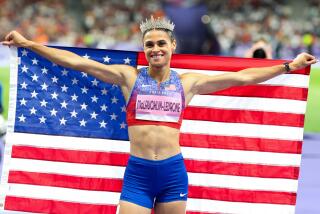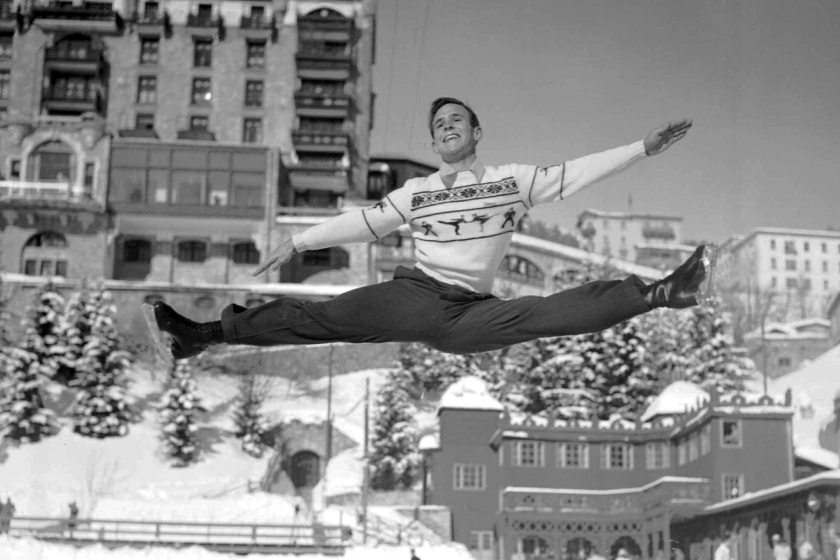Top Matchups Untracked
- Share via
EUGENE, Ore. — Craig Masback, a smart guy who, despite that, campaigned for and accepted the job as executive director of USA Track & Field, attacks corporate America as aggressively as he once did the mile.
“We have a greater heritage than any other sport,” he says in his sales pitch on behalf of the sport, mentioning the names Jesse Owens, Wilma Rudolph, Bob Mathias, Florence Griffith Joyner, Jackie Joyner-Kersee and Carl Lewis.
In 1993, the last time the national championships were held at Hayward Field, two of those athletes, Joyner-Kersee and Lewis, were still competing.
Both, however, had made it clear they would not continue in the sport long beyond the 1996 Summer Olympics in Atlanta. Already there was concern that no athlete, with the possible exception of Michael Johnson, would emerge to carry track and field in this country into the next millennium.
Of course, someone invariably emerges, and, in the late ‘90s, two who did were Marion Jones and Maurice Greene.
Jones, twice the national prep athlete of the year while at Thousand Oaks High before concentrating on basketball at North Carolina, rededicated herself to the sport in 1997 and by year’s end had become world champion at 100 meters.
She was No. 1 in the world in the 100, 200 and long jump last year, becoming the second-fastest woman ever in the 100 behind Griffith Joyner.
Greene, who not long after leaving high school in Kansas City, Kan., upset Lewis in a 100 and now trains in Westwood, also became a world champion in the 100 in 1997 and, less than two weeks ago, set the world record at 9.79 seconds.
It was a great time and should have been even better timing for the attention-starved sport in the United States.
Imagine seeing the newly ordained world’s fastest man running his next competitive 100 at the national championships right here in Track City, U.S.A.
Imagine seeing Jones running against Gail Devers, the two-time Olympic 100 champion, for supremacy in the event.
You’ll have to imagine it.
The International Amateur Athletic Federation, the sport’s governing body, offered automatic invitations to this summer’s World Championships in Seville, Spain, to defending champions.
As a result, Greene and Jones don’t have to be here in order to qualify for the U.S. team.
Fortunately for the sport, they are here because they hope to compete in Seville in other events.
Jones accomplished that modest goal Friday in the long jump, finishing second to Dawn Burrell while favoring a slight knee injury, and is entered in the 200. Greene is in the men’s 200, although his much-anticipated race against Johnson on Sunday evaporated when the world record-holder in that event withdrew Friday night because of a pulled leg muscle. Johnson didn’t enter his other gold medal event, the 400, because--you guessed it--he is the defending world champion.
And so it goes.
When the gun went off in the 100 finals Friday, neither Jones nor Greene was at the starting line, devaluing an event that--with a heritage that includes Owens, Lewis, Bob Hayes, Rudolph, Griffith Joyner, Wyomia Tyus and Evelyn Ashford--has been the most glamorous and prestigious in the 123-year history of the national championships.
It also raises a question about the value of a national championship.
That’s not to say that there should be an asterisk beside the names of Friday’s 100 winners, Inger Miller and Dennis Mitchell. But they have to wonder whether they would have won if Jones and Greene had entered.
You might expect that Masback got mad when the IAAF sabotaged the U.S. meet.
No, that’s a sports columnist’s job.
Masback got busy.
“If national championships are not so important that people don’t want to win one, then it’s my job to make them important enough,” he said. “We need to make it so compelling that they don’t even think of not competing.”
In the post-amateur world, the word “compelling” comes with a dollar sign.
“We will have prize money by 2001,” he said.
The obvious question is where USATF plans to find the money. When Masback left a lucrative practice with Lloyd Cutler’s Washington law firm to become executive director two years ago, the federation was virtually bankrupt.
In the months since, sponsorships have increased from $1.7 million to $7 million.
General Motors and Adidas are new sponsors. Budweiser is expected to become one. Others will follow, Masback promised.
Meantime, he is going to enjoy the track meet.
With Masback, track and field not only has a past, it has a present and a future.
*
Friday’s other women’s winners were Connie Price-Smith in the shotput at 61-10 1/2, her eighth consecutive title; Stacey Bowers in the triple jump at 44-9 3/4; and Sheila Burrell in the decathlon with 6,101 points.
The men’s champions were Adam Goucher in the 5,000 in 13:25.59; Olympic gold medalist Charles Austin in the high jump at 7-5 3/4; Lance Deal in the hammer throw at 263-7, the longest throw by an American this year; and Chris Huffins in the decathlon with 8,350 points.
Randy Harvey can be reached at his e-mail address: [email protected].
More to Read
Go beyond the scoreboard
Get the latest on L.A.'s teams in the daily Sports Report newsletter.
You may occasionally receive promotional content from the Los Angeles Times.






